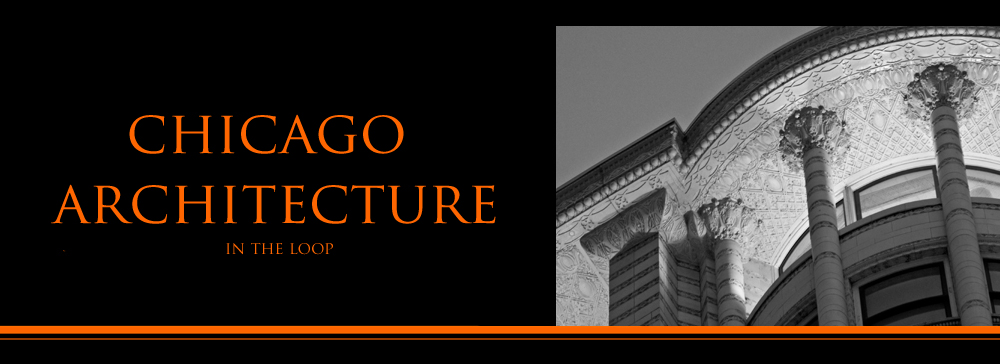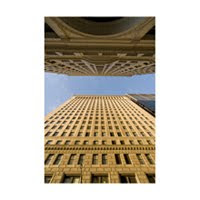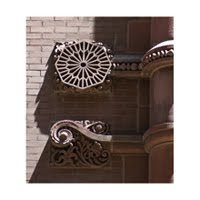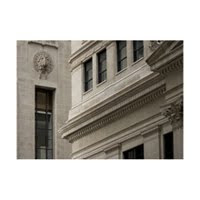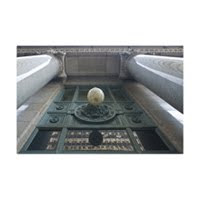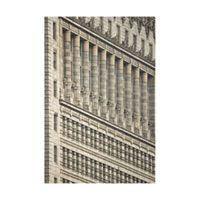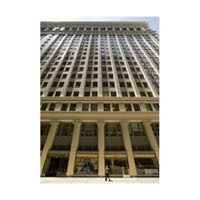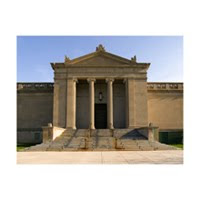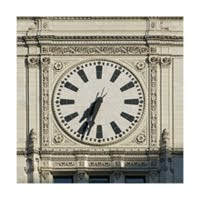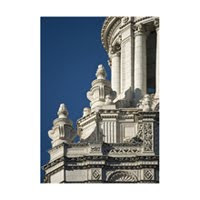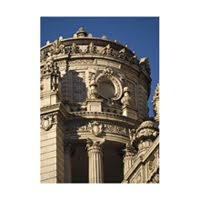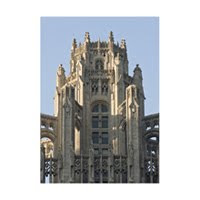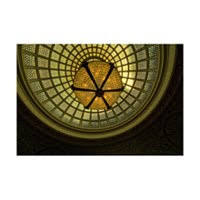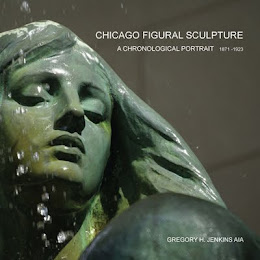I will be on vacation through July 5. A well deserved rest, I think. In the meantime, enjoy my Flickr Site, ARCHITECTURE IN THE LOOP. There are 28 Photo Sets describing Chicago Architecture in the Loop. Link HERE.
And when you're done, enjoy the link page. Chicago has the best community of Architecture Bloggers in the Country. Link HERE for the list. (And if I've missed one, let me know!)
And if you're still interested in "more" Architecture, Sculpture and Photography, visit THE CHICAGO LOOP.org Link HERE
Tuesday, June 22, 2010
Sunday, June 20, 2010
DANIEL BURNHAM. Orchestra Hall
THE STORY
Within our lifetimes, dates blur. Facts are forgotten or rewritten Conjecture replaces truth. Men disappear. And so follow these paragraphs of speculation, best guesses from facts available......
Early 1904 may have been one of the happiest times of Daniel Burnham's life. Two young Beaux Arts Diplomes worked briefly together in Burnham's Chicago Office -- Peirce Anderson soon to be on his way to the Plan of Manila and Ed Bennett on his way to San Francisco. (These men were the future.) The MacMillan Plan for Washington DC and the 1903 Plan for Cleveland had been a success. D.H. Burnham & Company was a well-oiled machine, thanks in good part to Ernest Graham and the experienced staff. And Chicago was growing again. The dark years following the Fair were over. His sons , Hubert and Dan Jr.were to be educated as architects. More good news.
.
.
The Chicago Symphony Orchestra's new home was "on the Boards." Bryan Lathrop, President of the Chicago Symphony had requested that the facade of their "new home" be Georgian. Conservative, respectable Georgian. CSO Trustee Burnham was glad to comply. This was an important commission.
Burnham, true to form, assembled the most effecient team available for the Orchestra Hall project.. He, personally, oversaw the general building layout. Joachim Giaver took responsibility for structural engineering. The Beaux-Arts designers, Ed Bennett and Peirce Anderson, (working together for the first time since graduation from the Ecole), finished in charette, the Grainger Ballroom and the Beaux Arts ornament for the great Concert Hall. Frederick Dinkelberg was given primary responsibility for the facade. But for the Georgian detail, Burnham engaged old friend, Stanford White from New York's McKim, Mead, and White.
Burnham, true to form, assembled the most effecient team available for the Orchestra Hall project.. He, personally, oversaw the general building layout. Joachim Giaver took responsibility for structural engineering. The Beaux-Arts designers, Ed Bennett and Peirce Anderson, (working together for the first time since graduation from the Ecole), finished in charette, the Grainger Ballroom and the Beaux Arts ornament for the great Concert Hall. Frederick Dinkelberg was given primary responsibility for the facade. But for the Georgian detail, Burnham engaged old friend, Stanford White from New York's McKim, Mead, and White.
White had been in Chicago regularly for his work with Augustus Saint Gaudens (including the Standing and the Seated Lincolns and the Logan Memorial. He also worked with the Lincoln Park Commission and the South Parks Commission at Congress Plaza). Thoroughly trusted by Lathrop ( a good, close second choice to Charles McKim) White (that's Stannie White) had the added credential of being a good guy, a bon vivant, adept at all the luxiries that Gilded Age had to offer.
Orchestra Hall turned out beautifully, reflecting the varied talents of the team that produced it. (They all dunnit. Obviously!) But life takes turns. And truth is often better than fiction. (Here we return to fact)
The first concert took place in Orchestra Hall in December of 1904. In January of 1905, the Orchestra's conductor, Theodore Thomas was dead. Stanford White, whose architecture so carefully reflected order and reserve, had carried his private life to new extremes: an affair with 17 year old New York chorus girl, Evelyn Nesbitt, became public. (So much for Georgian respectability.) In 1906 (soon after the San Fransico earthquake) Evelyn's new husband, Harry Thaw, shot Stannie White three times in the face -- on the roof of Madison Square Garden. The sensational trial that followed destroyed McKim, Mead and White. Daniel Burnham had missed Orchestra Hall's opening Concert (and a good thing, too -- the Chicago Tribune panned the Hall's accoustics) , while travelling to Manila with Peirce Anderson. He was certainly beginning to feel the ill health that in 1906 brought him the prognosis of "three years to live." It was that prognosis that began the political machinations, within his office, for control of the Daniel Burnham empire. Dinkelberg lost to Anderson. Giaver and Bennett left. Burnham's sons eventually sold their stakes to Ernest Graham.
And so, for this post at any rate, and to complete the story (and without specific documentation it remains a story) (the happy story of 1904) I post, instead of architecture (we know the building), photographs of some of the characters. Characters we no longer know.
DANIEL BURNHAM
THEODORE THOMAS
PEIRCE ANDERSON
STANFORD WHITE
EVELYN NESBITT THAW
Instead of three years, Burnham lived for six. Plenty of time for what has become his crowning achievement: The Plan of Chicago.
Bryan Lathrop died in 1916. Rating an Obit in the New York Times. And an In Memoriam written by Edgar Lee Masters.
Evelyn Nesbitt died in Santa Monica in 1967.
Evelyn Nesbitt died in Santa Monica in 1967.
____________________
FOR MORE CHICAGO ARCHITECTURE, SCULPTURE AND PHOTOGRAPHY
LAUNCH AT
____________________
Friday, June 18, 2010
DANIEL BURNHAM.
ORCHESTRA HALL
Charles McKim??
Charles McKim??
It would be an easy leap to guess that Charles McKim (partner in the architectural firm of McKim, Mead and White), designer of the Bryan Lathrop Residence on east Bellevue Place worked with Daniel Burnham, at Lathrop's request, on the design of Orchestra Hall. Lathrop, president of the Symphony, and an important, respected supporter of the Arts in Chicago, would have had the "clout" to select the structure's design. And Burnham had worked well with McKim Mead and White at the Columbian Exposition. The cache of a respectably "Georgian" Orchestra Hall created by the foremost architects of Chicago and New York would have been very attractive.
In those first years of the 1900's he was kinda busy.

With New York's Penn Station.
But it is my guess (and here I will admit to all speculation) that McKim was not the designer. I don't think the two structures came from the same "hand." The Lathrop Residence IS Georgian. Standing on the veranda (or sitting on the balustrade with your back to Bellevue Place) you are quite transported to London. Elegant, delicately scaled ornament touches the arches. The home rests horizontally on its veranda/plinth. Decorative stone bands define each story and further empasize the horizontal weight of the mass. But most importantly, it took a very confident hand to locate the front entrance off center and to further ornament that opening with assymetrical patterns. And let's not forget those little corbelled chimneys.
.
.
Orchestra Hall, on the other hand, is an application of Georgian Style to an eight story building. (With an elevator.) It is solidly symmetrical. The Georgian is good. Very good. Right down to the brick's flemish bond. But the proportions hint of the vertical. The plinth is indicated by the entire first floor, and is surmounted by a piano nobile. And details are scaled to the larger mass of Orchestra Hall. (And I think I see a Burnham "bottom-middle-top" lurking in the facade.)
And one more thing would lead me to believe that McKim would not have contributed to our little Chicago project.

With New York's Penn Station.
So whodunnit? Beaux Arts Anderson is headed for Manila, Chicago School Dinkelberg and Weber seem not to have the experience. McKim is tied up in New York........
_________________________
For CHICAGO Books, Blogs and Photographs
visit
Tuesday, June 15, 2010
DANIEL BURNHAM. Orchestra Hall.
THE DEVIL IN THE DETAILS.
Continuing our mystery (see previous post).....who designed Orchestra Hall?
Georgian Architecture is broadly described as late 18th C and early 19th C interpretations of neo-classicism. Which is code for what we generally call Colonial. In the late 19th C and early 20th C interest revived in Colonial Architecture (then renamed Colonial or Georgian Revival) particularly among those who defined themselves as America's upper class. So it is no surprise that the 1904 Orchestra Hall should have been constructed in, what was then, the very trendy, ultra respectable, Georgian motif. (Remember that description -- "ultra respectable") (You may need it in our next post)
.
Georgian Architecture was much simplified from the styles that preceded it. Balance, proportion, simplicty, and symmetry were of utmost importance. Link to additional photos of Orchestra Hall HERE.
The most famous example of Georgian Architecture in Chicago is the Bryan Lathrop House -- which preceded Orchestra Hall by some 12 years. Bryan Lathrop's selection of the very refined Georgian style in the face of Richardsonian Romanesque was a fairly gutsy step in 1892. Remembering that John Root and Louis Sullivan were Chicago's trendsetters.
.
But back to Orchestra Hall and our first interesting coincidence. Bryan Lathrop (among other cultural endeavors) was the President of the Chicago Symphony Orchestra from 1899 - 1916 and over saw the construction of Orchestra Hall.. The golden rule of any mystery (especially in the selection of Design Architects) is "to follow the money." And Bryan Lathrop had lots of it.
_________________________
The Art Institute has a very nice exhibit describing the Lathrop House at 120 East Belleview. Link HERE for details.
I can't take credit for connecting Bryan Lathrop to the Chicago Symphony: thanks are due Chicago Architecture Foundation docent (and FB friend) Rick Lightburn for that enlightenment. Link HERE for a schedule of the fine CAF walking tours of Symphony Center. Standing on the stage of the Chicago Symphony Orchestra is an experience not to be missed.
_________________________
Link HERE to follow CHICAGO IMAGES on FACEBOOK.
Saturday, June 12, 2010
D.H.BURNHAM & Co. Orchestra Hall. A Good Old-Fashioned Georgian Mystery.
D.H. Burnham and Company produced a remarkable series of designers. Each with a clear sense of aesthetic and a stylistic signature. Following John Root (who is a separate story), Charles Atwood produced both Neo-classicism (the Fine Arts Building at the Columbian Expostion) and Chicago School Masterpieces (including the Reliance and the Fisher). Frederick Dinkelberg continued with Atwood's Chicago School aesthetic and began the transition of Burnham's work to the Beaux Arts (The Heyworth, The Railway Exchange and The Conway). Peirce Anderson took Burnham "international" in the Beaux Arts movement with remarkable interpretations of the classical including the Illinois Merchants Bank and the Field Museum. A few others including Peter Weber, George Nimmons, and Dwight Perkins also designed buildings for Burnham, but they tended to the Chicago School and were responsible primarily for lesser buildings.
.
Clearly Georgian, it is D.H. Burnham and Company's Orchestra Hall, built in 1904. GEORGIAN. Either designed by one of Burnham's own, whose penchant for Georgian (and this Georgian is well done) went somehow unnoticed -- or the design came from someplace or someone else.
I love a mystery.
_________________________
FOR IMAGES OF CHICAGO'S LANDMARK ARCHITECTURE AND HISTORIC SCULPTURE
VISIT CHICAGO IMAGES IN THE LOOP ON
Monday, June 7, 2010
D.H. BURNHAM & COMPANY, Architect. Frederick Dinkelberg, Designer. The Effect of Ornament.
The "rules" of ornament are nearly the same on D.H. Burnham's Heyworth Building as for Sullivan's adjacent Schlessinger and Mayer: separate (though varying) motifs for columns, lintels, conices and jambs. Sullivan added a couple of extras (a couple) -- at the intersection of column and lintel, and of course, at the great corner entry. But, conceptually, they are in the same ballpark. And I'll admit to getting a little emotional over both. (I'm looking forward to looking at Sullivan in detail -- after more than a year of blogging Burnham's Chicago buildings), But there are still some Burnham mysteries to be solved.
.
It appears that in the early "oughts" Daniel was concepturally running two offices: his at-home Chicago School (Dinkelberg included) and his national and international Beaux Arts applications, with Peirce Anderson (from Washington to Manilla). This must have made some interesting "political " maneuvering in the break room. Anderson didn't fully gain the upper hand until 1908, along with Mssrs. Graham, Probst and White. As the Heyworth took its place next to Schessinger and Mayer, and the existing Silversmith, it might have been possible to believe, for the moment, that Beaux Arts was not a "threat" to names like Nimmons, Perkins, Weber and Dinkelberg. What alliances were made, what promises given that solidified the future of "Paris on the Lake?" To be the proverbial "fly on the wall" .....
____________________
Only a few more Burnhams to go. But I've started photography for the next round. And if you'd like to peek ahead, link HERE
____________________
FOR MORE CHICAGO ARCHITECTURE, SCULPTURE AND PHOTOGRAPHY
VISIT
Labels:
Daniel Burnham,
Fred Dinkelberg,
Heyworth Building
Friday, June 4, 2010
D.H. BURNHAM & COMPANY, ARCHITECT Frederick Dinkelberg, Designer The Heyworth. Organization of Ornament
Frederick Dinkelberg chose different design motifs to ornament the Heyworth's architectural features.: Cornice (classic anthemion); Columns (a vaguely art nouveau complexity of interlocking panels); Lintels (a geometry of repetitive discs); and Jambs (interlocking circles).
CORNICE (Above)
COLUMN (Below
LINTEL (Above)
JAMB (Below)
While each of these patterns is common to the period, (Holabird and Roche particularly favored the anthemion) the assemblage draws a remarkable play of light accross the facade and depth of the Heyworth. I'm learning that one of best criteria to assess the quality of a building is how it looks in the lens. And the Heyworth looks very good.
The Heyworth doesn't even rate an entry in my well worn AIA Guide to Chicago. Happily the City of Chicago Landmarked it in September of 2000. Link HERE.
SEE THE NEW JUNE 2010 IMAGE GALLERY
AT
Subscribe to:
Posts (Atom)
